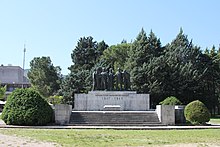Trebinje
Trebinje (Serbian Cyrillic: Требиње, pronounced [trěːbiɲe]) is a city and municipality in Republika Srpska entity, Bosnia and Herzegovina.
The city lies in the Trebišnjica river valley, at the foot of Leotar, in southeastern Herzegovina, some 30 km (19 mi) by road from Dubrovnik, Croatia, on the Adriatic coast.
After it passes through the Popovo Polje area southwest of the city, the river – which always floods in the winter – naturally runs underground to the Adriatic, near Dubrovnik.
Trebinje experiences a humid subtropical climate (Cfa) with heavy precipitation, typical of the southern Adriatic coastal areas.
Tribulium was the original name for this settlement, and the etymology of it may be analyzed as tri-bulium, or the place of the 'three hills', from the numeral 'three' (*trei-) and an appellative derived from the IE root *b(h)eu- 'to swell, puff.
Serbian Prince Vlastimir (r. 830–51) married his daughter to Krajina, the son of Beloje, and that family became hereditary rulers of Travunija.
The Old Town-Kastel was built by the Ottomans on the location of the medieval fortress of Ban Vir, on the western bank of the Trebišnjica River.
Among noble families in the Trebinje region mentioned in Ragusan documents were Ljubibratić, Starčić, Popović, Krasomirić, Preljubović, Poznanović, Dragančić, Kobiljačić, Paštrović, Zemljić and Stanjević.
[9] The burning of Saint Sava's remains after the Banat Uprising provoked the Serbs in other regions to revolt against the Ottomans.
During the Herzegovina Uprising (1875–77), the Bileća and Trebinje region was led by serdar Todor Mujičić, Gligor Milićević, Vasilj Svorcan and Sava Jakšić.
New administrative division was introduced and a large number of Austro-Hungarian troops were located in Trebinje, which was seen as a city of strategic value and position.
[15] After the Assassination of Archduke Franz Ferdinand Croat-Muslim volunteer corps (German: Schutzcorp) terrorized Serb civilians of Bogojevići and other villages in Trebinje, which resulted in 83 children killed and 85 adults hanged.
The imperial administrators also modernized the town, expanding it westwards, building the present main street, as well as several squares, parks, schools, tobacco plantations, etc.
It was controlled by Bosnian Serb forces from the fall of 1991, and was used as a major command and artillery base by Yugoslav People's Army (JNA) troops besieging the Croatian town of Dubrovnik.
The 15th-century Tvrdoš monastery is located two kilometres south-west of Trebinje, including a church which dates back to late antiquity.
The festival is held at a variety of venues, including the Amphitheater Crkvina, KCT culture center Trebinje, local music school, Villa Lastva, and the Museum of Herzegovina.
The following table gives a preview of total number of registered people employed in legal entities per their core activity (as of 2018):[21] Trebinje is twinned with: Una-Sana Central Bosnia Posavina Herzegovina-Neretva Tuzla West Herzegovina Zenica-Doboj Sarajevo Bosnian Podrinje Canton 10










